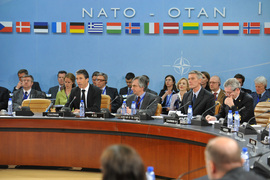Effective and efficient state defence institutions under civilian and democratic control are fundamental to stability in the Euro-Atlantic area, and essential for international security cooperation.
Many Partner countries are just beginning this long and difficult process, often with scarce resources and limited experience. As a response, the PAP-BID is now in place to assist Partners in carrying out these reforms.
What does this mean in practice?
The Action Plan for Defence Institution Building defines common objectives for Partnership work in this area, encourages exchange of relevant experience, and helps tailor and focus bilateral defence and security assistance programmes for Partner countries, to support them in overcoming the difficulties of reforms.
The Action Plan’s objectives include: effective and transparent arrangements for the democratic control of defence activities; civilian participation in developing defence and security policy; effective and transparent legislative and judicial oversight of the defence sector; enhanced assessment of security risks and national defence requirements, matched with developing and maintaining affordable and interoperable capabilities; optimising the management of defence ministries and other agencies which have associated force structures; compliance with international norms and practices in the defence sector, including export controls; effective and transparent financial, planning and resource allocation procedures in the defence area; effective management of defence spending as well as of the socio-economic consequences of defence restructuring; effective and transparent personnel structures and practices in the defence forces; and effective international cooperation and good neighbourly relations in defence and security matters.
How did it evolve?
In recognition of the importance of civilian and democratic control of armed and security forces, the Partnership Action Plan for Defence Institution Building was launched at NATO’s Istanbul Summit in June 2004, and endorsed by the Heads of State and Government of 49 NATO and Partner countries.
Which NATO bodies have a central role?
Implementation of the Action Plan will make maximum use of existing EAPC and PfP tools and mechanisms. The Planning and Review Process mechanism will serve as a key instrument for implementing the Action Plan’s objectives and it will be adapted as required.

